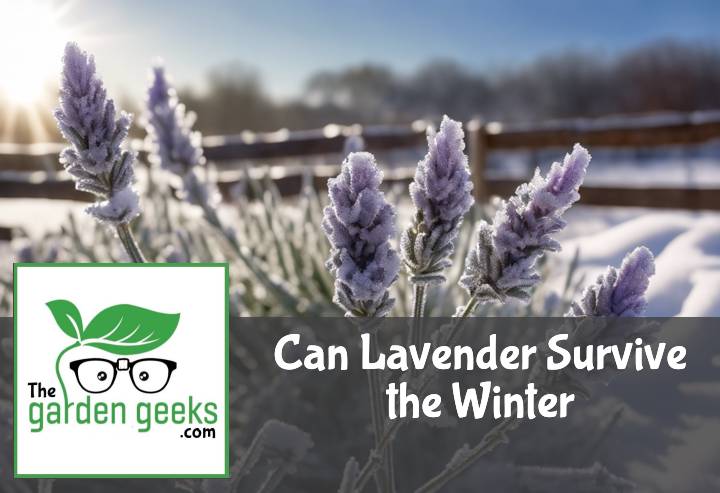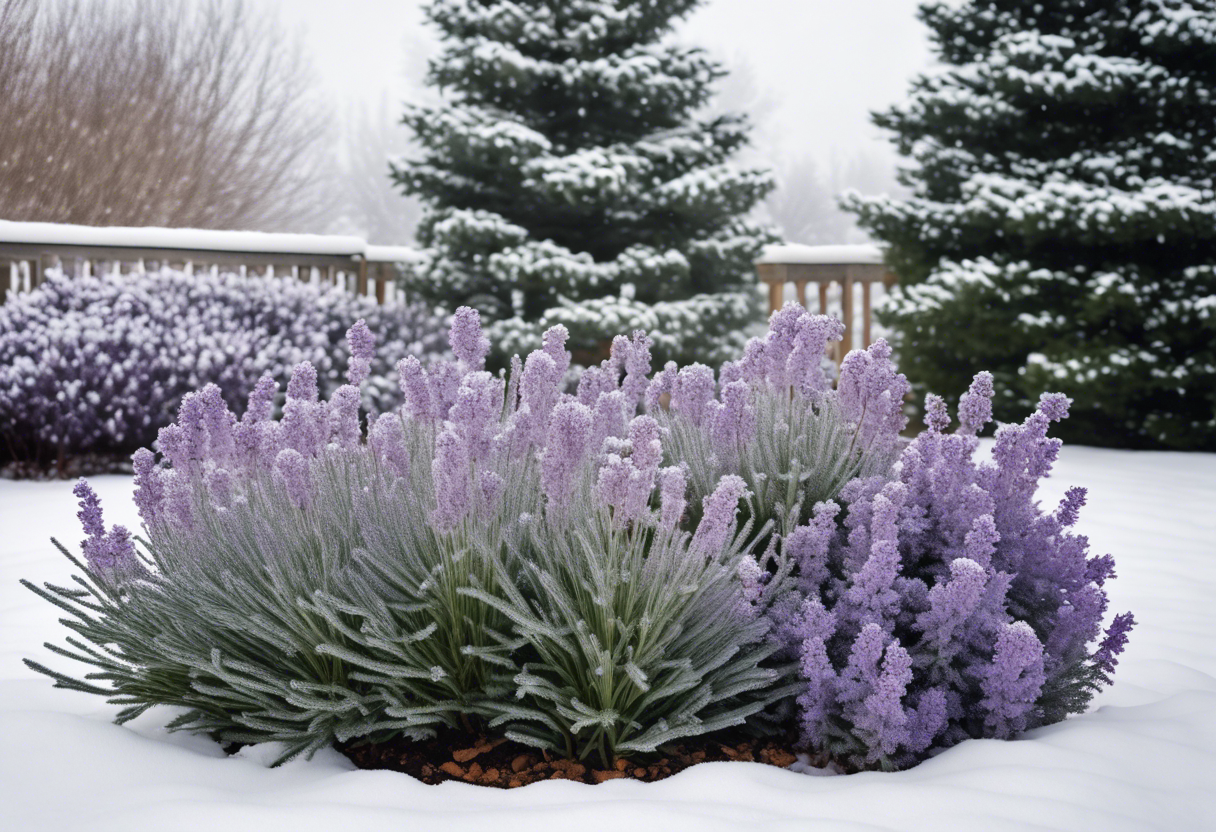Hey there, green thumbs! Ever found yourself staring at your beautiful lavender plant, sipping a cup of hot cocoa on a chilly winter day and wondering, Can Lavender Survive the Winter? Well, you’re not alone. I’ve been there too, my friend.
So grab your gardening gloves and dig into this post with me as we explore the resilience of these fragrant beauties during winter. Keep reading about ‘Can Lavender Survive the Winter’? You betcha!
Key Takeaways
- Lavender can survive winter, but its survival depends on the specific variety and the climate conditions.
- Hardy varieties like English lavender can tolerate cold winters better than others.
- In harsh climates, lavender requires protection such as mulching or covering with horticultural fleece.
- Indoor cultivation during winter is an option for less hardy varieties.
- Proper pruning after the first frost helps to increase the plant’s winter survival rate.
Understanding Lavender Plants
Lavender, a plant of beauty and versatility, hails from the Mediterranean region. Known for its vibrant purple flowers and soothing fragrance, it’s a favorite among gardeners worldwide. But here’s the kicker – not all lavenders are created equal. Some varieties are hardier than others, especially when it comes to surviving winter.
The Nature of Lavender
Lavender plants have a growth habit that can be described as bushy and compact. They love basking in full sun and thrive in well-drained soil. Now don’t get me wrong, they’re not too fussy about soil quality, but they do prefer it on the alkaline side.
Their uses? Oh boy, where do I start? From perfumes to cooking, these plants are as versatile as they come. And let’s not forget their therapeutic properties! A whiff of lavender oil can send your stress packing faster than you can say ‘Can Lavender Survive the Winter‘.
Types of Lavender and Their Hardiness
Now onto the different types of lavender plants. English lavender (Lavandula angustifolia) is known for its hardiness. It laughs in the face of cold winters! Then there’s French lavender (Lavandula stoechas), which prefers warmer climes.
But wait, there’s more! We also have Spanish lavender (Lavandula latifolia). This one is somewhere in between – not too fond of freezing temperatures but can handle a bit of chill.
So there you have it folks – whether your lavender will survive winter or not really depends on what type you’ve got planted in your garden!
Can Lavender Survive the Winter?
Well, it’s a bit of a yes and no situation. Lavender winter survival largely depends on the specific type of lavender and the conditions it’s exposed to. Some are cold hardy lavender, while others need a bit more TLC when Jack Frost comes knocking.
Factors Affecting Lavender’s Winter Survival
The key to helping your lavender survive winter lies in understanding its needs. First off, lavender care in winter is all about balance. Too much water can be as harmful as too little, especially if your soil doesn’t drain well.
Speaking of which, soil drainage for lavender is crucial. Soggy roots can lead to root rot, which is basically a death sentence for your plant. So make sure your soil drains faster than my bank account during holiday season!
Next up is sunlight. Even in winter, your lavender still needs its daily dose of Vitamin D. So remember to consider the sunlight needs for lavender when choosing where to plant.
Temperature also plays a big role in Can Lavender Survive the Winter? Most lavenders are pretty tough cookies and can handle temperatures down to -10°C (14°F). But anything colder might have them pushing up daisies instead of blooming beautifully.
Last but not least, don’t forget about mulching! A good layer of mulch can provide extra insulation and protection against frost. It’s like giving your plants their own personal blanket during those chilly winter months.
How Different Types of Lavender Respond to Winter
Now let’s talk about how different types of lavender respond to winter conditions. For instance, English lavenders like Hidcote and Munstead are known for their hardiness. They’re like the Bear Grylls of the lavender world – they can survive pretty much anything!
On the other hand, French and Spanish lavenders are a bit more delicate. They’re like the divas of the lavender world – they need a bit more pampering and protection from harsh conditions.
Hybrid lavenders, like the Lavandin group, have a mixed bag of traits. Some are frost-resistant champs, while others might need a bit more help to make it through winter.
So there you have it! Can Lavender Survive the Winter? Well, with the right care and conditions, most certainly yes! But remember, every lavender is unique – just like us humans. So get to know your lavender and give it what it needs to thrive all year round!
Preparing Lavender for Winter
Winterizing lavender plants is a crucial step to ensure they thrive even in the coldest months. It’s all about lavender care in winter and taking steps like proper planting and pruning. This not only helps in protecting lavender in cold weather but also sets the stage for a flourishing spring.
Proper Planting for Winter Survival
The first step towards ensuring your lavender survives the winter is proper planting. The type of soil plays a significant role here. The best soil for lavender in winter is well-draining, preventing root rot from excess water. Also, consider where you’re planting – where to plant lavender for winter survival can make a big difference. A sunny spot with good airflow works best! Lastly, don’t forget about positioning and improving drainage for your lavender plants.
Pruning Techniques for Winter Preparation
Now let’s talk about pruning, another important aspect of winter preparation for lavender. Knowing when to prune lavender before winter is key – late summer or early fall usually does the trick. But it’s not just about timing; it’s also about how you prune. Using the right techniques can help prepare your lavenders for the cold weather ahead, enhancing their chances of survival through winter. So remember folks, when it comes to answering “Can Lavender Survive the Winter?“, proper pruning plays a huge part!
Caring for Lavender During Winter
When it comes to winter lavender care, it’s all about the right balance. You see, can lavender survive the winter? Absolutely! But it needs a little TLC (tender, love, and care) to make it through those chilly months.
Watering and Feeding in Cold Months
Now, let’s talk about watering and feeding your lavender during winter. It’s a bit different than your usual routine.
Lavender plants don’t need as much water in the colder months. So, cut back on your winter watering schedule for lavender. Overwatering can lead to root rot which is a big no-no for our purple friends.
Feeding is also crucial for maintaining plant health in winter. A slow-release fertilizer applied at the start of winter should do the trick. Remember, we’re focusing on feeding lavender in cold weather, not overfeeding!
Protecting Your Plant from Frost and Snow
Alrighty then, moving onto frost and snow protection. This part is critical if you want to prevent any Jack Frost nipping at your plant’s buds.
Wrap up your lavender plants with horticultural fleece or bubble wrap when frost is forecasted. This provides excellent frost protection for plants.
And what about snow? Well, believe it or not, a blanket of snow can actually insulate plants from extreme cold. But too much can cause damage so brush off excess snow gently from your lavender plants.
So there you have it folks! With these tips on cold weather plant maintenance, your lavenders will be singing “I Will Survive” all winter long!
Signs Your Lavender is Struggling in Winter
Winter can be a tough time for our lavender friends. But how do you know if your plant is just chillin’ or actually freezing? Well, there are some telltale signs that your lavender is struggling during the cold months.
Identifying Stress Symptoms in Your Plant
First off, let’s talk about lavender stress symptoms. If your lavender starts looking more like a dried herb than a vibrant plant, it might be feeling the winter blues.
Look out for physical changes – wilting leaves, discoloration, and slowed growth are all signs of an unhealthy lavender. It’s like when we humans get pale and sluggish during flu season – not a good look!
Another way to identify distress is through its scent. A stressed lavender may lose its signature aroma, which is kinda like us losing our sense of humor when we’re under the weather.
Steps to Revive a Struggling Lavender
Now that we’ve identified the problem, it’s time to play plant doctor. The first step in reviving struggling lavender is to check its environment. Is it getting enough sunlight? Is it too exposed to harsh winds? These factors can cause serious winter damage in lavenders.
Next up, consider adjusting your watering schedule. Overwatering can lead to root rot – another common issue for lavenders in winter. So go easy on the H2O!
Lastly, don’t forget about proper insulation. Wrapping your lavender with horticultural fleece can protect it from frost and help it survive the winter months.
Remember folks, can lavender survive the winter? Absolutely! With a bit of TLC and these care tips, you’ll have happy and healthy lavenders all year round!
To Wrap Up
So, Can Lavender Survive the Winter? Absolutely! Like a hibernating bear, lavender just needs a little extra care to make it through the winter.
Remember, don’t let your lavender turn into a popsicle! Keep it cozy with mulch and proper pruning. Now go show that winter who’s boss!





